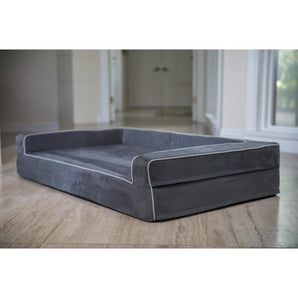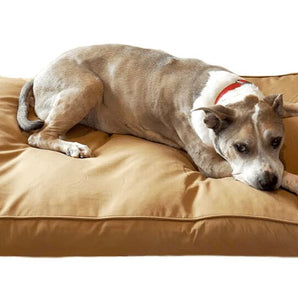You've likely heard of sleep apnea in humans—it’s one of the most common sleep disorders, causing snoring, breathing difficulties, and excessive daytime sleepiness. But did you know that sleep apnea in dogs is a thing, too? That’s right—your furry friend can also develop sleep apnea.
So, how do you know if your dog has a sleep disorder? What are the sleep apnea symptoms to look out for? Read on to find out.
Can Dogs Have Sleep Apnea?
Yes! While sleep apnea in dogs isn’t as common as in humans, it does happen—especially in certain breeds. Just like with people, canine sleep apnea is characterized by sleep-disordered breathing, meaning your dog may stop breathing for short periods while sleeping. This can cause them to wake up suddenly, struggle to fall back asleep, or even experience trouble breathing throughout the night.
Obstructive Sleep Apnea vs. Brachycephalic Obstructive Airway Syndrome (BOAS) in Dogs
Not all breathing difficulties in dogs are caused by sleep apnea alone. In fact, Brachycephalic Obstructive Airway Syndrome (BOAS)—a condition that affects flat-faced breeds like Bulldogs, Pugs, and Boxers—can actually contribute to sleep apnea in dogs. Because these breeds already have narrowed airways, elongated soft palates, and smaller nostrils, they are more prone to breathing problems, especially when they fall asleep.
While BOAS and obstructive sleep apnea share similar symptoms, they are distinct conditions. However, BOAS can make a dog more likely to develop sleep apnea due to its impact on normal airflow.
How BOAS Can Lead to Sleep Apnea
- Chronic Airway Obstruction: BOAS causes persistent sleep-disordered breathing, which can worsen at night when the muscles around the airway relax. This increases the risk of airway collapse, leading to pauses in breathing during sleep—classic sleep apnea symptoms.
- Snoring and Labored Breathing: Dogs with BOAS already struggle with breathing difficulties, and when they sleep, their soft tissues can further obstruct airflow, increasing the likelihood of suspected obstructive sleep apnea episodes.
- Higher Risk in Overweight Dogs: Since BOAS-prone breeds are also at higher risk for obesity, excess weight can place additional pressure on their airway, making it even more difficult to breathe—both awake and asleep.
How to Tell If Your Dog Has a Sleep Disorder

Here are some sleep apnea symptoms to watch for:
- Loud, frequent snoring (more than your average adorable pup snore)
- Gasping or choking sounds while sleeping
- Restlessness at night and difficulty staying asleep
- Excessive daytime sleepiness or lethargy
- Noticeable breathing problems when at rest
If your dog also experiences breathing problems throughout the day and struggles to keep up with exercise or regulate their body temperature, BOAS is likely the primary issue. However, if your pup stops breathing for short periods during sleep, gasping for air, or experiencing trouble breathing at night, sleep apnea may be the culprit.
How Does Sleep Apnea Affect a Dog's Health?
While the idea of a snoring pup might seem cute, sleep apnea in dogs is no laughing matter. This sleep disorder can have serious consequences, impacting everything from their energy levels to their long-term health. When a dog stops breathing repeatedly during sleep, it deprives their body of much-needed oxygen, putting extra stress on their organs. Over time, this can contribute to breathing problems, heart complications, and a significant decline in their overall quality of life.
Reduced Oxygen Intake
A dog with sleep apnea experiences frequent interruptions in breathing, leading to lower oxygen levels in their bloodstream. These constant drops in oxygen can put a strain on major organs, particularly the heart and lungs, increasing the risk of cardiovascular issues and respiratory distress.
Without enough oxygen, dogs may wake up feeling groggy or disoriented, making it harder for them to fall asleep again. Over time, poor sleep can weaken their immune system, making them more susceptible to infections and other health problems. If your pup is frequently gasping for air or waking up multiple times throughout the night, their breathing difficulties could be causing a dangerous cycle of oxygen deprivation.
In severe cases, prolonged sleep apnea symptoms can lead to high blood pressure, chronic inflammation, and even a shorter lifespan. This is why addressing suspected obstructive sleep apnea early is crucial to ensuring your dog stays healthy and happy.
Quality of Life
Just like in humans, sleep apnea can seriously affect your pup’s overall well-being. Dogs with trouble breathing at night may struggle to get restful sleep, making them cranky, sluggish, and less active during the day. Instead of waking up ready for playtime and walks, they may seem disinterested or even irritable.
Lack of sleep can also cause behavioral changes—some dogs become more anxious, while others may exhibit signs of depression. Since dogs rely on quality sleep to regulate their mood and energy, chronic sleep-disordered breathing can make them feel constantly exhausted, affecting their ability to engage with their environment and family.
Managing and Preventing Sleep Apnea in Dogs

While sleep apnea in dogs can be a serious condition, the good news is that there are several ways to treat sleep apnea and improve your pup’s sleep quality. Addressing sleep-disordered breathing early on can help prevent long-term health issues and ensure your dog stays active, happy, and well-rested.
Just as with sleep apnea in humans, prevention and management strategies often depend on the underlying cause. Unlike humans, though, dogs can't use a CPAP (continuous positive airway pressure) machine as a first line of treatment. For some dogs, weight management and creating a better sleep environment can make a significant difference. In more severe cases, medications or even surgical intervention may be necessary to open up restricted airways.
Weight Management
One of the most important factors in reducing sleep apnea symptoms is keeping your dog at a healthy weight. Obesity is a leading cause of breathing difficulties in dogs, as excess fat around the neck and throat can put pressure on the airway, making it more likely to collapse during sleep. If your pup is carrying a little extra weight, it can significantly increase their risk of obstructive sleep apnea.
A well-balanced diet and regular exercise routine can make a huge difference in reducing sleep-disordered breathing. Switching to low-calorie, high-protein foods and incorporating more interactive play sessions can help your dog shed excess weight in a fun and healthy way. If you’re unsure of the best diet plan, consult your vet to create a personalized approach for your dog’s specific needs.
Sleep Environment
The right sleeping conditions can make a world of difference for dogs suffering from breathing problems. Ensuring that your dog has a breathable, supportive, chew-proof dog bed kept in a cool, quiet, and well-ventilated space can help them breathe easier while they sleep. Overheating can make trouble breathing even worse, so keeping the room at a comfortable temperature and avoiding excessive bedding can help prevent airway obstructions.
If your pup is a brachycephalic breed (such as a Pug or Bulldog), elevating their bed slightly may also improve airflow. Some pet owners even use small air purifiers to reduce allergens in the environment, which can further reduce sleep-disordered breathing caused by allergies or congestion.
Medication
In some cases, medication can help treat sleep apnea in dogs, particularly if the condition is linked to issues with airway control. Certain medications that affect serotonin, dopamine, and norepinephrine levels have been found to help regulate sleep-disordered breathing and reduce the frequency of breathing problems during sleep.
While medications can help manage sleep-disordered breathing, they are typically used as part of a broader treatment plan that includes weight management, environmental adjustments, and potential surgical interventions. Always consult with your veterinarian before introducing any medication to ensure it is the right option for your pup’s pet health needs.
Surgery
For dogs with severe sleep-disordered breathing, surgery may be the last option to help them breathe more comfortably. This is especially common in brachycephalic breeds, where obstructive sleep apnea is often caused by a narrow airway, elongated soft palate, or stenotic (narrowed) nostrils.
Surgical options may include soft palate resection, nostril widening, or removing excess tissue from the airway to reduce breathing problems. While surgery can be highly effective, it is not without risks and should always be considered a last resort after other management strategies have been exhausted.
When to See a Veterinarian
If you notice signs of suspected obstructive sleep apnea—like frequent snoring, trouble breathing, or extreme tiredness—it’s time to consult your vet. They can assess your pet’s risk, recommend treatment options, and determine if further intervention might be necessary.
While sleep apnea in dogs isn’t as commonly diagnosed as in humans, it’s still important to recognize the signs and take action early. A well-rested pup is a happy, healthy pup—so don’t snooze on this one!





